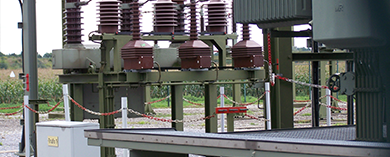
- (03) 5909 8218
- enquiry@fusionweld.com.au
What is an Electrical Fit-out
May 30, 2014

There are limitless configuration possibilities for pressure vessels and storage units. The systems integrate a variety of specifications designed to link mechanical assemblies together, maximizing flow or isolating entire subsystems, but each component of the whole is subject to a controlling influence. Pneumatic valves open and close in response to positive or negative feedback while pumps and piping regulate the pressure within vessels rated to handle a specific gas or liquid at a determined temperature. This system of operation varies slightly from chemical platform to gas refinery or manufacturing plant, but they're all managed by electrical systems, perhaps adding an injection of pneumatics or hydraulics in specialized situations. These active electrical components are accompanied by instrumentation packages, essential systems that monitor an assigned group of parameters such as input and output variables, levels of released pollutants, the pressure of the stored contents of the storage vessel, and much more.
It's a management configuration comprised of factory-assembled electrical components, as assigned to the storage vessel industry, and it falls under the category of electrical control systems. They're the modular assemblies of wiring, the powered motors that drive mechanical pumps, and the various examples of electrically powered instrumentation that sit on the framework of plant equipment competing for space with a complex trail of pipe spooling. Technically, it's the stages of power distribution that define the site of the electrical fit-out, the initial framework of electrical input terminals encased in insulation, but the term often extends to encompass the majority of electrical parts dispersed across the vessel. That's the electrical isolation switching, the grounding cables and bonding apparatus that protects against accidents and the intrusion of lightning strikes. Secondary and tertiary subsystems such as general utility electrics can also join the electrical fit-out, elements of practical consideration that cover lighting and power outlets when maintenance is being carried out on the storage unit. Indeed, some electrical distribution blueprints destined for storage platforms can cover multiple levels of the design, reaching up to the sky and several levels below ground, perhaps filling a role as a drainage pump.
Manufacturing the bare-bones configuration of a specialized tank or storage container is one option, but it could be considered a less efficient model of operation in comparison to tailoring the structure to include the majority of the final design. Dress the platform and vessel with the electrical fit-out at the factory and reduce time constraints when installing the unit at its destined location, integrating the pipes and fixtures to the predetermined fittings in a plug-and-play manner as favored by smaller designs. The approach may not always be practical for shipping and freight concerns, but it's bound to save time onsite. Additionally, extra engineering concerns and productivity questions may be raised when opting to dress a platform or vessel as the unit is constructed, but the general workflow is sure to cut costs and time, as well as deliver a level of quality that meets various ISO quality standards such as the much desired 9001 certification.
Contact Details
Fusion - Weld Engineering Pty Ltd
ABN 98 068 987619
1865 Frankston Flinders Road,
Hastings, VIC 3915
Ph: (03) 5909 8218
Optimized by NetwizardSEO.com.au
Recent Posts
- Compressed Hydrogen Storage Vessels: Material Selection, Design & Australian Standards
- Welding QA/QC in Oil & Gas Pressure Vessel Fabrication – Ensuring Code Compliance
- AS1210 vs ASME VIII Pressure Vessel Code: Key Differences for Australian Projects
- Mitigating Hydrogen-Induced Cracking in Pressure Vessels: Engineering and Material Strategies
- Storage Tank Solutions Australia: Field-Erected, Prefabricated & Self-Bunded Explained
- Reducing Environmental Risks: Self-Bunded Tanks in Australian Oil & Gas Operations
- Precision in Production: How Pressure Vessels Are Manufactured for Industrial Safety
- Shell & Tube Heat Exchangers: Improve Thermal Control & Energy Recovery in Petrochemical & Pharmaceutical Plants
- In-Service Inspection for Compressed Air Receivers for Power Plant Shutdown Prevention
- Power Plant Pipe Spooling Fabrication – Get Rapid, Code-Compliant Spools Ready for Installation
- Field Erected Tanks: Safe, Reliable On-Site Fuel Storage Solutions in Australia
- Custom Pressure Vessel Fabrication for Flammable Gases
Posts 2025
- Compressed Hydrogen Storage Vessels: Material Selection, Design & Australian Standards
- Welding QA/QC in Oil & Gas Pressure Vessel Fabrication – Ensuring Code Compliance
- View all articles…
Posts 2024
- Large Process Vessels: Optimising the Design for Maximum Efficiency [2025]
- Pressure Equipment Management System Installation: Detect Equipment Faults Early
- View all articles…
Posts 2023
- Pressure Piping System Inspection: A Gift of Safety for the Holidays
- Deaerator Inspections by Fusion-Weld Engineering and How They Reduce System Downtime
- View all articles…
Posts 2022
- How Fusion Weld Keeps Up With AS-NZS ISO 9001:2008 Standard
- Boiler Equipment Safety Inspection During the Summer Season
- View all articles…
Posts 2021
- Avoid These Factors and Practices that Contribute to Sealing Damage in Pressure Vessels
- Do's And Don'ts Of Industrial Boiler Inspection And Maintenance From Fusion-Weld
- View all articles…
Posts 2020
- What are the Risks and Hazards Involved in Pressure Vessel Equipment?
- How to Know if Your Pressure Equipment Needs Repair or Replacement?
- View all articles…
Posts 2019
- Factors that Contribute to Pressure Vessel Failure
- Pressure Vessel Regulations in Australia: What are the Mandatory Requirements?
- View all articles…
Posts 2018
- Pros and Cons of Spherical vs. Cylindrical Pressure Vessels
- What are the Different Hazard Levels in Pressure Vessels?
- View all articles…
Posts 2017
- Transportable Pressure Vessels: The Importance of Inspection and Safety Checks
- Fracture Mechanics and Stress Analysis of Cracks in Pressure Vessels
- View all articles…
Posts 2016
Posts 2015
- What Are Deaerators & Feedwater Vessels?
- Precautions and Safety for Compressed Air Receiver Vessels
- View all articles…
Posts 2014
- Demonstrating In-process Inspection Procedures
- Static Grounding Practices and Standards
- View all articles…